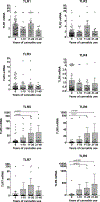Alcohol and cannabis use alter pulmonary innate immunity
- PMID: 30419300
- PMCID: PMC6509015
- DOI: 10.1016/j.alcohol.2018.11.002
Alcohol and cannabis use alter pulmonary innate immunity
Abstract
Purpose: Cannabis use is increasing due to recent legislative changes. In addition, cannabis is often used in conjunction with alcohol. The airway epithelium is the first line of defense against infectious microbes. Toll-like receptors (TLR) recognize airborne microbes and initiate the inflammatory cytokine response. The mechanism by which cannabis use in conjunction with alcohol affects pulmonary innate immunity mediated by TLRs is unknown.
Methods: Samples and data from an existing cohort of individuals with alcohol use disorders (AUDs), along with samples from additional participants with cannabis use alone and with AUD were utilized. Subjects were categorized into the following groups: no alcohol use disorder (AUD) or cannabis use (control) (n = 46), AUD only (n = 29), cannabis use-only (n = 39), and AUD and cannabis use (n = 29). The participants underwent bronchoscopy with bronchoalveolar lavage (BAL) and airway epithelial brushings. We measured IL-6, IL-8, TNF⍺, and IL-10 levels in BAL fluid, and performed real-time PCR for TLR1-9 on the airway epithelial brushings.
Results: We found significant increases in TLR2 with AUD alone, cannabis use alone, and cannabis use with AUD, compared to control. TLR5 was increased in cannabis users compared to control, TLR6 was increased in cannabis users and cannabis users with AUD compared to control, TLR7 was increased in cannabis users compared to control, and TLR9 was increased in cannabis users compared to control. In terms of cytokine production, IL-6 was increased in cannabis users compared to control. IL-8 and IL-10 were increased in AUD only.
Conclusions: AUD and cannabis use have complex effects on pulmonary innate immunity that promote airway inflammation.
Keywords: Alcoholism; Cigarette smoke; Ethanol; IL-6; IL-8; Marijuana; TNF⍺; Toll-like receptors.
Copyright © 2018 Elsevier Inc. All rights reserved.
Figures




References
-
- Baldwin GC, Tashkin DP, Buckley DM, Park AN, Dubinett SM, Roth MD (1997) Marijuana and cocaine impair alveolar macrophage function and cytokine production. Am J Respir Crit Care Med 156: 1606–13. - PubMed
Publication types
MeSH terms
Substances
Grants and funding
LinkOut - more resources
Full Text Sources
Medical

